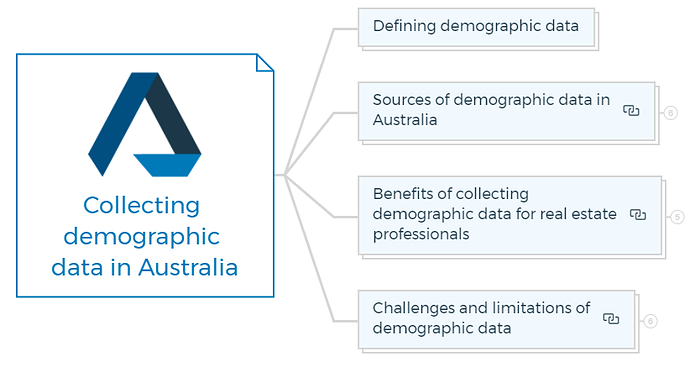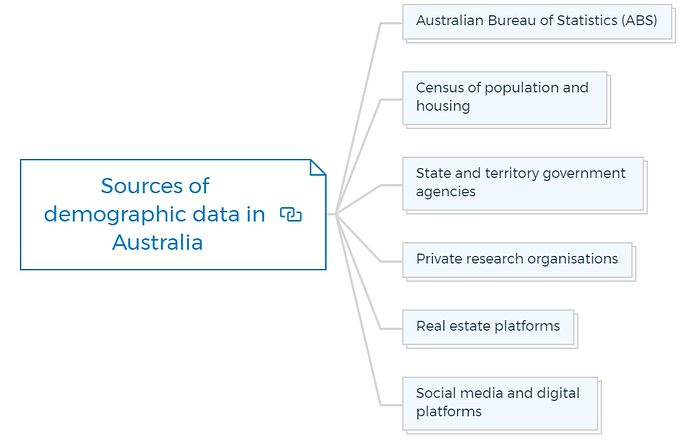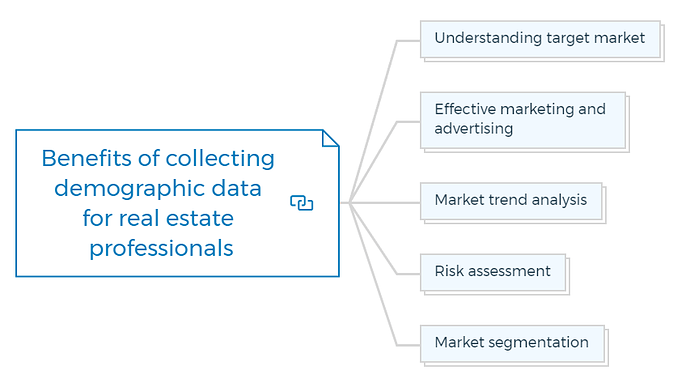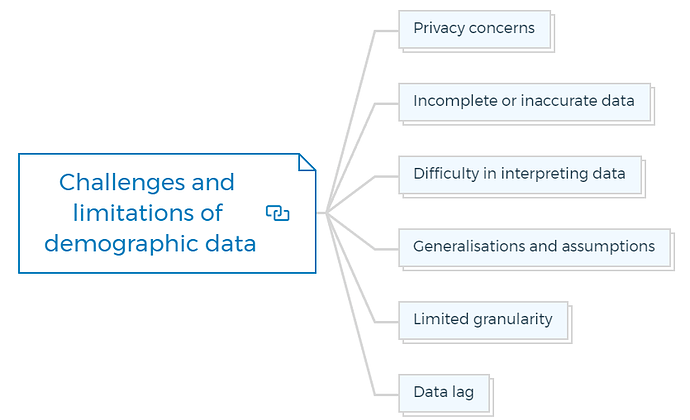Demographic data
Let’s look at some of the data sources. Where do you find the data for all the demographic indicators, including population, age, income group, average age, etc?
You will get a module on all reliable sources at the end of this property development course. For your ease, I will provide you with a file that you can import into your browser and quickly go and visit them.
Let’s learn how you can collect, understand, and use the data for your next property development deal.
To gain a comprehensive understanding of how to utilise specific websites for accessing real estate demographic data in Australia, please refer to the attached video.
The video will provide step-by-step guidance and practical demonstrations on navigating these websites and extracting valuable data for your real estate endeavours.
Defining demographic data
Demographic data describes a specific population or a group of people. Age, gender, income, education, marital status, occupation, and household composition are included.
This data helps real estate agents understand demographic preferences, demands, and behaviours. These variables allow them to target specific populations with their marketing, property options, and pricing.
You are missing out if you haven’t yet subscribed to our YouTube channel.
Sources of demographic data in Australia
Australia has many credible demographic data sources. These sources provide complete and current population data. Australian demographic sources include:
Australian Bureau of Statistics (ABS)
Australia’s main statistical agency is the ABS. They conduct regular surveys and censuses that cover a wide range of demographic factors such as age, gender, ethnicity, education, employment, income, and housing. Free data and reports are available at www.abs.gov.au.
Census of population and housing
Every five years, the ABS conducts a complete census of Australia’s population. The census tracks age, sex, language, income, education, occupation, and housing. Demographic analysis and planning use census data extensively.
State and territory government agencies
Each Australian state and territory has its own demographic data collection and publication agency. These agencies provide regional population growth, age distribution, and socioeconomic metrics.
New South Wales Department of Planning, Industry, and Environment and the Victorian Department of Jobs, Precincts, and Regions are examples.
Private research organisations
Private research organisations such as market research firms and consultancies conduct surveys and collect demographic data.
These organisations may focus on specific industries or demographics. Data may require a subscription or report purchase.
Real estate platforms
Online real estate platforms like realestate.com.au and Domain also gather demographic data.
Real estate professionals can learn about property preferences, location preferences, and search behaviours from property searchers. This real estate data can provide demographic insights.
Social media and digital platforms
Facebook, Twitter, LinkedIn, and digital advertising platforms collect user demographic data. This data helps advertisers target specific demographics.
Note that platforms may demand advertising relationships or agreements to access such data.
When using demographic data for real estate, it’s essential to critically analyse the data, assess any limits, and comply with appropriate privacy and data protection requirements.
Benefits of collecting demographic data for real estate professionals
Demographic data collection aids Australian real estate professionals. Demographic insights help professionals make informed decisions, modify their strategy, and acquire a competitive edge. Demographic data has several advantages:
Understanding target market
Demographics help real estate agents identify their target market. Professionals can discover demographic segment demands by analysing age, income, education, family composition, and lifestyle preferences.
This insight helps them target their marketing, property offerings, and price to increase sales.
Effective marketing and advertising
Demographic data helps real estate agents target marketing and advertising. Professionals may design captivating messaging and choose the right methods to reach their target customers or renters by analysing their audience.
This results in higher engagement rates, increased inquiries, and a higher likelihood of successful conversions.
Learn More
Market trend analysis
Demographic data helps real estate agents predict market demand. Professionals can identify new markets, predict demand for specific property types, and alter their strategy by analysing population trends, income levels, and household compositions.
This proactive attitude helps professionals keep ahead of the competition and seize new possibilities.
Demographics affect property pricing and investment decisions. Professionals can estimate property prices and ROI by examining income, employment, and affordability. This ensures that they make informed decisions that align with market demands and financial viability.
Risk assessment
Demographic data helps real estate professionals estimate risk and make judgements.
Professionals can assess a region’s stability and growth by examining population density, income stability, and economic indicators. This aids risk management and investing strategy.
Market segmentation
Demographic data helps real estate professionals segment the market and personalise their products.
Professionals can tailor property solutions to young professionals, families, retirees, and investors by understanding their needs and preferences. Targeting improves client satisfaction and transaction success.
Challenges and limitations of demographic data
Demographic data can help Australian real estate experts, but its collection and utilisation are difficult. Understanding these obstacles will aid professionals in data interpretation and decision-making.
Demographic data has several drawbacks:
Privacy concerns
Collecting and using demographic data involves handling personal information, which raises privacy concerns. Real estate agents must comply with data protection laws and protect their data. Ethical data management is crucial.
Incomplete or inaccurate data
Demographic data may be incomplete or erroneous. Errors or refusals may occur during data collection.
Data may be inconsistently collected across demographic characteristics or geographic areas. Real estate professionals should be aware of these restrictions and validate their data to ensure accuracy.
Difficulty in interpreting data
Complex datasets, meaningful patterns, and precise conclusions are difficult to analyse. Real estate professionals should learn data literacy and analysis to use demographic data for decision-making.
Generalisations and assumptions
Demographic data can reveal population features but avoid generalisations and assumptions. Each demographic group member has unique tastes and behaviours. Real estate agents should use demographic data, market research, and direct observations to identify their target audience.
Limited granularity
Demographic data may not be granular enough for certain studies. Regional or city data may not represent local differences. To acquire further insights, professionals may need to use localised data or focused surveys.
Data lag
Surveys or censuses every few years collect demographic data. Data lag might result in inaccurate population features and trends.
Real estate professionals might consider using additional data sources or real-time indicators to compensate for this lag.
Demographic data is helpful for real estate professionals despite these issues. Professionals can use demographic data to make informed judgements by knowing these constraints and using proper data analysis tools. Demographic data is crucial to real estate research and analysis.
Learn More
Test Your Knowledge
Practical Exercise on Demographics in Real Estate
Objective
This assignment is designed to test your understanding of how demographics impact real estate markets. Through a series of questions, To Do’s, and research tasks, you will explore the correlation between demographic data and real estate development, investment, and market dynamics.
Instructions:
- Read each question carefully and provide comprehensive answers.
- For To Do’s, follow the instructions to complete each task.
- For research questions, use credible sources to find the necessary information.
- Cite all sources used for research questions.
Questions:
Define Demographics
In your own words, explain what demographics are and why they are important in the context of real estate.
How do demographics affect real estate markets?
Provide examples of how changes in population size, age distribution, and household composition can influence the demand for residential properties.
To Do’s:
Analyze a Local Area
Choose a suburb or neighborhood in your local area. Collect demographic data including age, gender, income, education, occupation, and household size. Use public databases, local government resources, or real estate analytics tools for this task.
Market Analysis Report
Based on the demographic data collected, write a report analyzing the potential real estate market in your chosen area. Include sections on housing demand, preferences and amenities, affordability, and the rental market.
Research Questions:
Identify Trends
Research and identify a recent trend in real estate that has been influenced by demographic changes. Discuss the trend and how demographics have played a role in shaping it.
Case Study
Find a real estate development project that was specifically designed to cater to a particular demographic group (e.g., young families, empty nesters, retirees). Describe the project and how the developers used demographic data to inform their decisions on location, design, and amenities.
Practical Exercise:
Targeted Marketing Proposal
Create a marketing proposal for a hypothetical real estate development. Your proposal should target a specific demographic group identified in your local area analysis. Include strategies for marketing, location selection, pricing, and amenities designed to appeal to your target demographic.
Risk Assessment
Conduct a risk assessment for investing in a suburb that has shown a decline in population over the past years. Investigate the potential reasons for the decline and discuss the implications for real estate investment in that area.
Long-term Planning Exercise
Design a long-term real estate development plan for a location experiencing significant demographic shifts, such as urbanisation or an increase in a particular age group. Outline how your plan addresses these shifts and the types of developments proposed.
Submission Guidelines
- Compile your answers, reports, proposals, and assessments in a single document.
- Ensure your work is well-organized, with each section clearly labeled.
- Submit your document through email.








